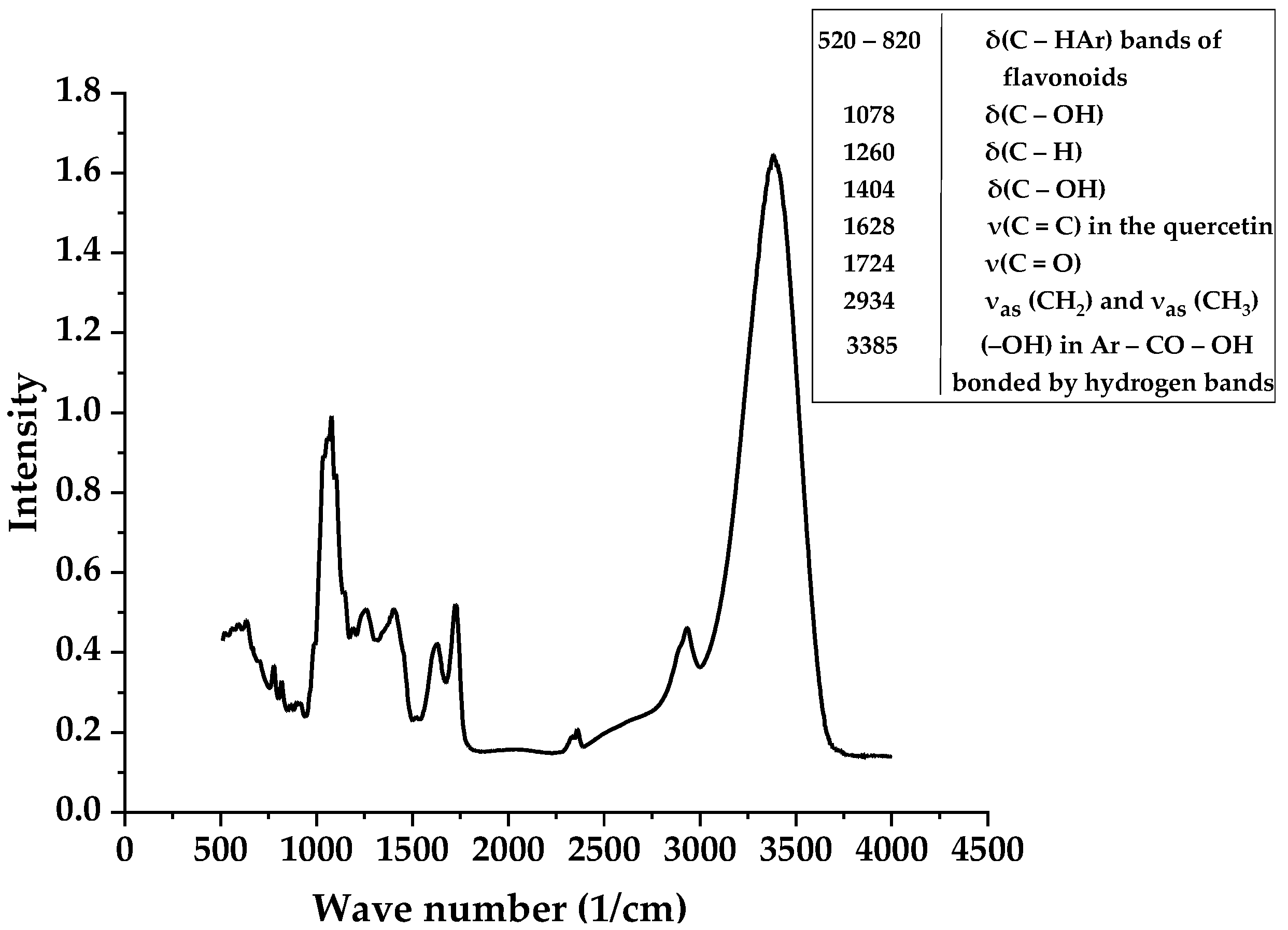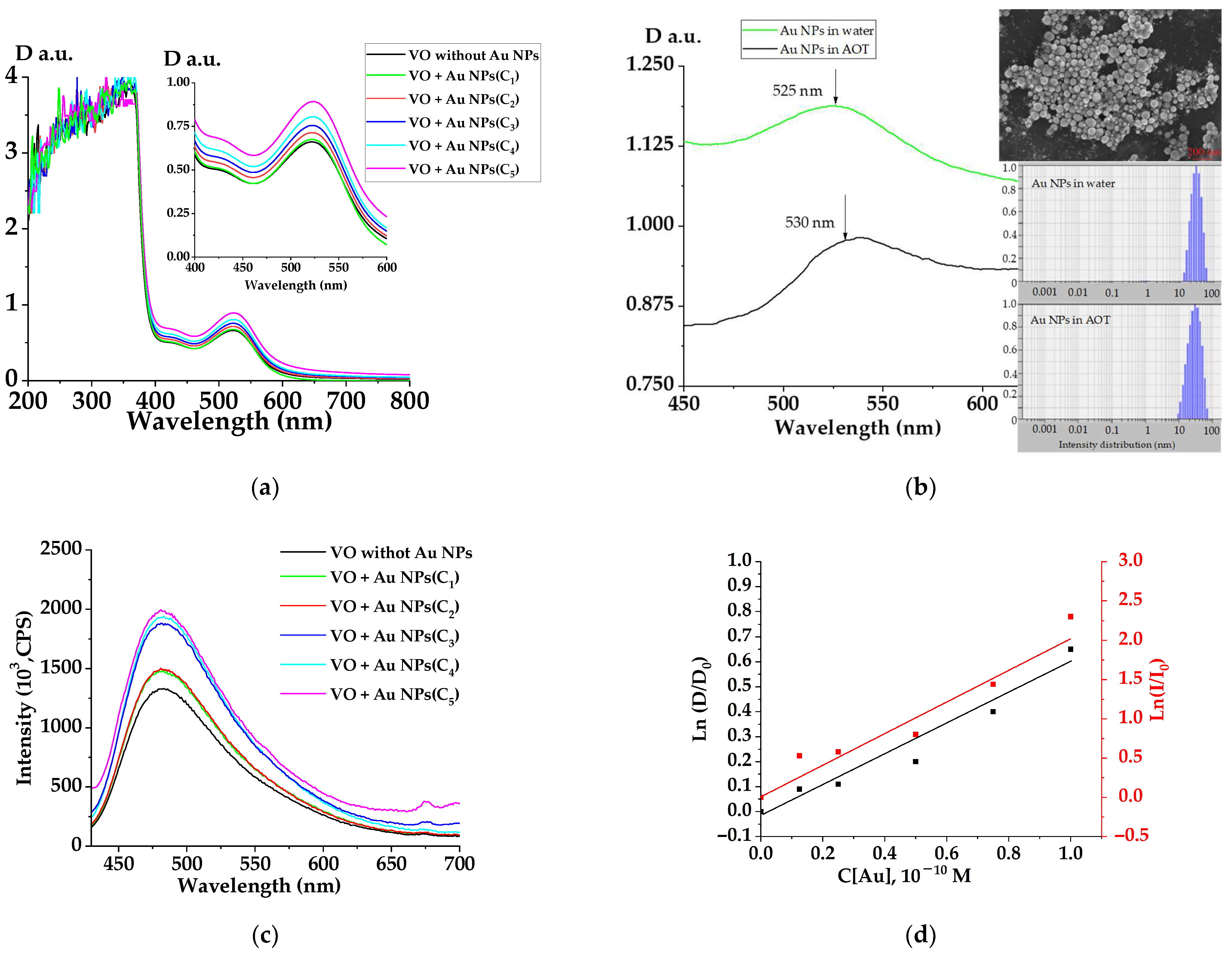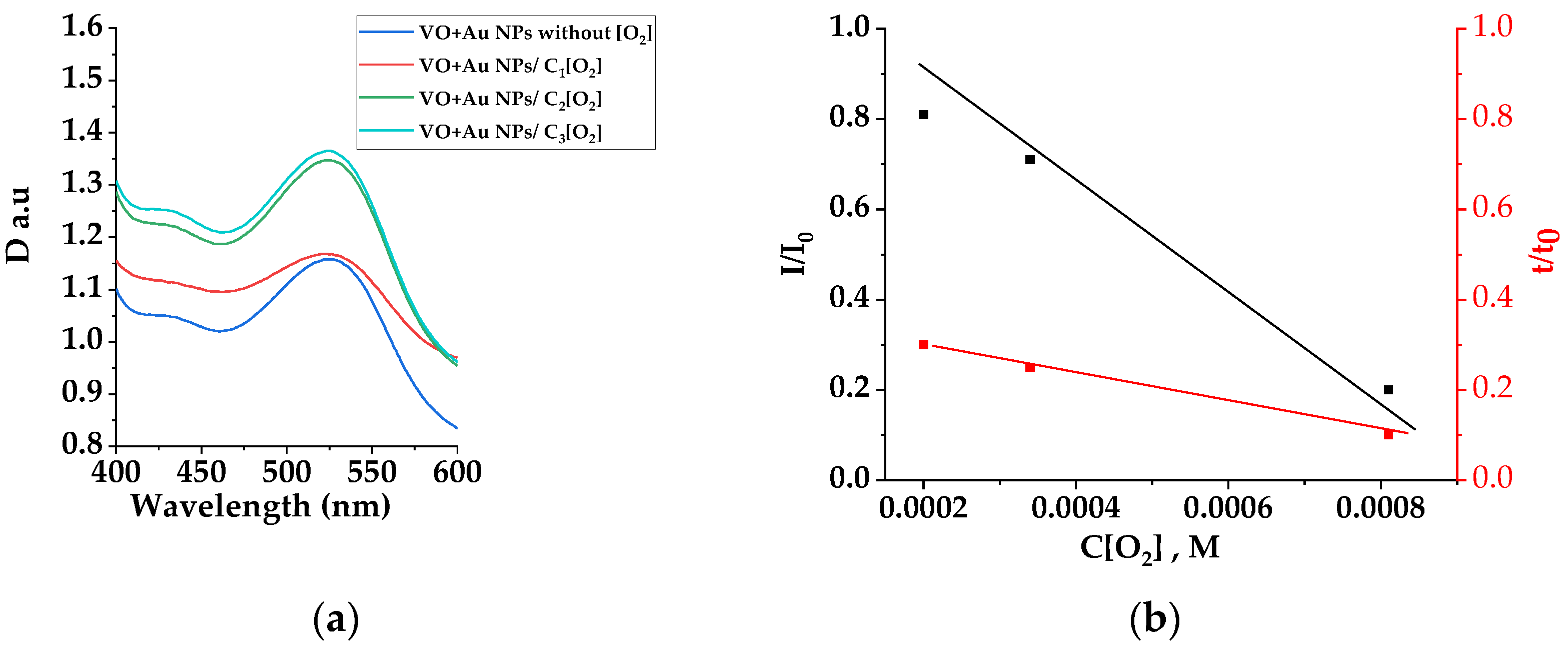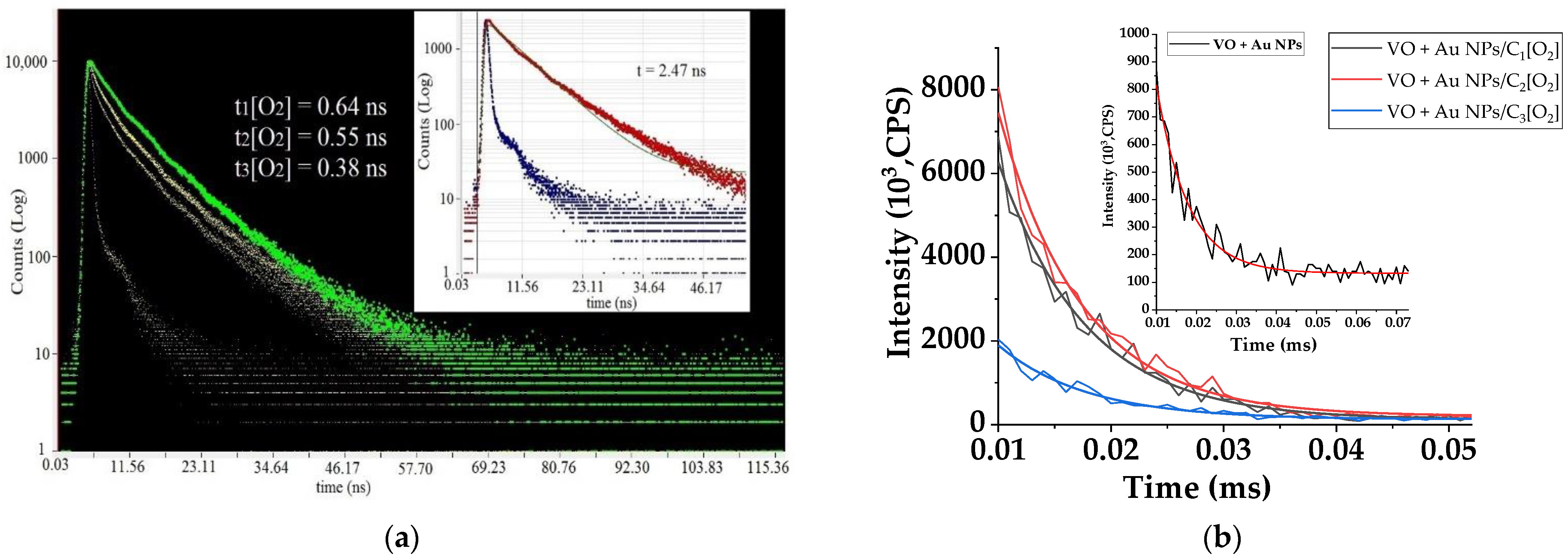Photonics of Viburnum opulus L. Extracts in Microemulsions with Oxygen and Gold Nanoparticles
Abstract
:1. Introduction
2. Materials and Methods
2.1. Sample Preparation
2.2. Gold Nanoparticle Preparation
2.3. Methods of Quantitative and Qualitative Determination of Flavonoids in Viburnum opulus L. Berries
2.4. Determination of Antioxidant Activity of Viburnum Extract with Gold Nanoparticles (DPPH Method)
2.5. Experimental Measurements
3. Results and Discussion
3.1. IR-Spectroscopy Results
3.2. Absorption and Luminescence Dynamics of Flavonoids from Viburnum opulus L. Extract with Gold Nanoparticles
3.3. Optical Properties and Time-Resolved Spectroscopy of Oxygen-Saturated Microemulsions with VO Extract and Gold Nanoparticles
4. Conclusions
Supplementary Materials
Author Contributions
Funding
Institutional Review Board Statement
Informed Consent Statement
Data Availability Statement
Conflicts of Interest
References
- Zakłos-Szyda, M.; Pawlik, N.; Polka, D.; Nowak, A.; Koziołkiewicz, M.; Podsędek, A. Viburnum opulus L. Fruit Phenolic Compounds as Cytoprotective Agents Able to Decrease Free Fatty Acids and Glucose Uptake by Caco-2 Cells. Antioxidants 2019, 8, 262. [Google Scholar] [CrossRef] [Green Version]
- Dienaitė, L.; Pukalskienė, M.; Pereira, C.V.; Matias, A.A.; Venskutonis, P.R. Valorization of European Cranberry Bush (Viburnum opulus L.) Berry Pomace Extracts Isolated with Pressurized Ethanol and Water by Assessing Their Phytochemical Composition, Antioxidant, and Antiproliferative Activities. Foods 2020, 9, 1413. [Google Scholar] [CrossRef]
- Mansoori, B.; Mohammadi, A.; Amin Doustvandi, M.; Mohammadnejad, F.; Kamari, F.; Gjerstorff, M.F.; Baradaran, B.; Hamblin, M.R. Photodynamic Therapy for Cancer: Role of Natural Products. Photodiagn. Photodyn. Ther. 2019, 26, 395–404. [Google Scholar] [CrossRef]
- Bruschi, M.L.; da Silva, J.B.; Rosseto, H.C. Photodynamic Therapy of Psoriasis Using Photosensitizers of Vegetable Origin. Curr. Pharm. Des. 2019, 25, 2279–2291. [Google Scholar] [CrossRef]
- Monjo, A.; Pringle, E.; Thornbury, M.; Duguay, B.; Monro, S.; Hetu, M.; Knight, D.; Cameron, C.; McFarland, S.; McCormick, C. Photodynamic Inactivation of Herpes Simplex Viruses. Viruses 2018, 10, 532. [Google Scholar] [CrossRef] [Green Version]
- Arciniegas, A.; Gómez-Vidales, V.; Pérez-Castorena, A.; Nieto-Camacho, A.; Villaseñor, J.L.; Romo de Vivar, A. Recognition of Antioxidants and Photosensitizers in Dyssodia Pinnata by EPR Spectroscopy. Phytochem. Anal. 2020, 31, 252–261. [Google Scholar] [CrossRef]
- Shi, S.; Cho, H.; Sun, Q.; He, Y.; Ma, G.; Kim, Y.; Kim, B.; Kim, O. Acanthopanacis Cortex Extract: A Novel Photosensitizer for Head and Neck Squamous Cell Carcinoma Therapy. Photodiagn. Photodyn. Ther. 2019, 26, 142–149. [Google Scholar] [CrossRef]
- Alam, S.T.; Hwang, H.; Son, J.D.; Nguyen, U.T.T.; Park, J.-S.; Kwon, H.C.; Kwon, J.; Kang, K. Natural Photosensitizers from Tripterygium Wilfordii and Their Antimicrobial Photodynamic Therapeutic Effects in a Caenorhabditis Elegans Model. J. Photochem. Photobiol. B Biol. 2021, 218, 112184. [Google Scholar] [CrossRef]
- Warowicka, A.; Popenda, Ł.; Bartkowiak, G.; Musidlak, O.; Litowczenko-Cybulska, J.; Kuźma, D.; Nawrot, R.; Jurga, S.; Goździcka-Józefiak, A. Protoberberine Compounds Extracted from Chelidonium Majus L. as Novel Natural Photosensitizers for Cancer Therapy. Phytomedicine 2019, 64, 152919. [Google Scholar] [CrossRef]
- Giacone, L.; Cordisco, E.; Garrido, M.C.; Petenatti, E.; Sortino, M. Photodynamic Activity of Tagetes Minuta Extracts against Superficial Fungal Infections. Med. Mycol. 2020, 58, 797–809. [Google Scholar] [CrossRef]
- Postigo, A.; Schiavi, P.C.; Funes, M.; Sortino, M. Mechanistic Studies of Candida Albicans Photodynamic Inactivation with Porophyllum Obscurum Hexanic Extract and Its Isolated Thiophenic Compounds. Photodiagn. Photodyn. Ther. 2019, 26, 420–429. [Google Scholar] [CrossRef]
- da Silva Souza Campanholi, K.; Jaski, J.M.; da Silva Junior, R.C.; Zanqui, A.B.; Lazarin-Bidóia, D.; da Silva, C.M.; da Silva, E.A.; Hioka, N.; Nakamura, C.V.; Cardozo-Filho, L.; et al. Photodamage on Staphylococcus Aureus by Natural Extract from Tetragonia Tetragonoides (Pall.) Kuntze: Clean Method of Extraction, Characterization and Photophysical Studies. J. Photochem. Photobiol. B Biol. 2020, 203, 111763. [Google Scholar] [CrossRef]
- Obi, K.; Frolova, L.; Fuierer, P. Preparation and Performance of Prickly Pear (Opuntia phaeacantha) and Mulberry (Morus rubra) Dye-Sensitized Solar Cells. Sol. Energy 2020, 208, 312–320. [Google Scholar] [CrossRef]
- Purushothamreddy, N.; Dileep, R.K.; Veerappan, G.; Kovendhan, M.; Joseph, D.P. Prickly Pear Fruit Extract as Photosensitizer for Dye-Sensitized Solar Cell. Spectrochim. Acta Part A Mol. Biomol. Spectrosc. 2020, 228, 117686. [Google Scholar] [CrossRef]
- Sampaio, D.M.; Babu, R.S.; Costa, H.R.M.; de Barros, A.L.F. Investigation of Nanostructured TiO2 Thin Film Coatings for DSSCs Application Using Natural Dye Extracted from Jabuticaba Fruit as Photosensitizers. Ionics 2019, 25, 2893–2902. [Google Scholar] [CrossRef]
- Paşayeva, L.; Kararenk, A.C.; Fatullayev, H. Screening of Different Fruit Extracts from Viburnum opulus L. as Inhibitors of Key Enzymes Linked to Type 2 Diabetes and Antioxidants: A Comparative Evaluation. J. Food Meas. Charact. 2021, 15, 4403–4410. [Google Scholar] [CrossRef]
- Chen, J.; Zhao, Z.; Zhang, X.; Shao, J.; Zhao, C. Recent Advance on Chemistry and Bioactivities of Secondary Metabolites from Viburnum Plants: An Update. Chem. Biodivers. 2021, 18, e2100404. [Google Scholar] [CrossRef]
- Pietrzyk, N.; Zakłos-Szyda, M.; Koziołkiewicz, M.; Podsędek, A. Viburnum opulus L. Fruit Phenolic Compounds Protect against FFA-Induced Steatosis of HepG2 Cells via AMPK Pathway. J. Funct. Foods 2021, 80, 104437. [Google Scholar] [CrossRef]
- Wu, X.; Xie, J.; Qiu, L.; Zou, L.; Huang, Y.; Xie, Y.; Xu, H.; He, S.; Zhang, Q. The Anti-Inflammatory and Analgesic Activities of the Ethyl Acetate Extract of Viburnum Taitoense Hayata. J. Ethnopharmacol. 2021, 269, 113742. [Google Scholar] [CrossRef]
- Zhang, Y.-Y.; Chen, J.-J.; Li, D.-Q.; Zhang, Y.-; Wang, X.-B.; Yao, G.-D.; Song, S.-J. Network Pharmacology Uncovers Anti-Cancer Activity of Vibsane-Type Diterpenes from Viburnum Odoratissimum. Nat. Prod. Res. 2021, 35, 637–640. [Google Scholar] [CrossRef]
- Bozali, K.; Guler, E.M.; Gulgec, A.S.; Kocyigit, A. Cytotoxic, Genotoxic and Apoptotic Effects of Viburnum opulus L. on Colon Cancer Cells: An in Vitro Study. Turkish J. Biochem. 2020, 45, 803–810. [Google Scholar] [CrossRef]
- Kajszczak, D.; Zakłos-Szyda, M.; Podsędek, A. Viburnum opulus L.—A Review of Phytochemistry and Biological Effects. Nutrients 2020, 12, 3398. [Google Scholar] [CrossRef]
- Lakowicz, J.R. Principles of Fluorescence Spectroscopy, 3rd ed.; Lakowicz, J.R., Ed.; Springer: Boston, MA, USA, 2006; ISBN 978-0-387-31278-1. [Google Scholar]
- Zhen, S.; Yi, X.; Zhao, Z.; Lou, X.; Xia, F.; Tang, B.Z. Drug Delivery Micelles with Efficient Near-Infrared Photosensitizer for Combined Image-Guided Photodynamic Therapy and Chemotherapy of Drug-Resistant Cancer. Biomaterials 2019, 218, 119330. [Google Scholar] [CrossRef]
- Kustov, A.V.; Krestyaninov, M.A.; Kruchin, S.O.; Shukhto, O.V.; Kustova, T.V.; Belykh, D.V.; Khudyaeva, I.S.; Koifman, M.O.; Razgovorov, P.B.; Berezin, D.B. Interaction of Cationic Chlorin Photosensitizers with Non-Ionic Surfactant Tween 80. Mendeleev Commun. 2021, 31, 65–67. [Google Scholar] [CrossRef]
- Lakowicz, J.R.; Ray, K.; Chowdhury, M.; Szmacinski, H.; Fu, Y.; Zhang, J.; Nowaczyk, K. Plasmon-controlled fluorescence: A new paradigm in fluorescence spectroscopy. R. Soc. Chem. 2008, 133, 1308–1346. [Google Scholar] [CrossRef] [Green Version]
- Sarid, D.; Challener, W. Modern Introduction to Surface Plasmons: Theory, Mathematica Modeling, and Applcations, 1st ed.; Sarid, D., Ed.; Cambridge University Press: Cambridge, UK, 2010; ISBN-13: 978-0521767170. [Google Scholar]
- Maier, S.A. Plasmonics: Fundamentals and Applications; Springer: New York, NY, USA, 2007; ISBN 978-0-387-33150-8. [Google Scholar]
- Kalimuthu, K.; Cha, B.S.; Kim, S.; Park, K.S. Eco-Friendly Synthesis and Biomedical Applications of Gold Nanoparticles: A Review. Microchem. J. 2020, 152, 104296. [Google Scholar] [CrossRef]
- Darabdhara, G.; Das, M.R.; Singh, S.P.; Rengan, A.K.; Szunerits, S.; Boukherroub, R. Ag and Au Nanoparticles/Reduced Graphene Oxide Composite Materials: Synthesis and Application in Diagnostics and Therapeutics. Adv. Colloid Interface Sci. 2019, 271, 101991. [Google Scholar] [CrossRef]
- Singh, R.P.; Handa, R.; Manchanda, G. Nanoparticles in Sustainable Agriculture: An Emerging Opportunity. J. Control. Release 2021, 329, 1234–1248. [Google Scholar] [CrossRef]
- Kumar, S.; Basumatary, I.B.; Sudhani, H.P.K.; Bajpai, V.K.; Chen, L.; Shukla, S.; Mukherjee, A. Plant Extract Mediated Silver Nanoparticles and Their Applications as Antimicrobials and in Sustainable Food Packaging: A State-of-the-Art Review. Trends Food Sci. Technol. 2021, 112, 651–666. [Google Scholar] [CrossRef]
- Khandanlou, R.; Murthy, V.; Wang, H. Gold Nanoparticle-Assisted Enhancement in Bioactive Properties of Australian Native Plant Extracts, Tasmannia Lanceolata and Backhousia Citriodora. Mater. Sci. Eng. C 2020, 112, 110922. [Google Scholar] [CrossRef]
- Omolaja, A.A.; Pearce, B.; Omoruyi, S.I.; Badmus, J.A.; Ismail, E.; Marnewick, J.; Botha, S.; Benjeddou, M.; Ekpo, O.E.; Hussein, A.A. The Potential of Chalcone-Capped Gold Nanoparticles for the Management of Diabetes Mellitus. Surf. Interfaces 2021, 25, 101251. [Google Scholar] [CrossRef]
- Hammami, I.; Alabdallah, N.M.; Al Jomaa, A.; Kamoun, M. Gold Nanoparticles: Synthesis Properties and Applications. J. King Saud Univ.-Sci. 2021, 33, 101560. [Google Scholar] [CrossRef]
- Dan, S.; Upadhyay, S.K.; Girdhar, M.; Mandal, M. Sakshi Oral Carcinoma and Therapeutic Approaches of Nanotechnology: From Fundamental Concepts, Incidence, Molecular Mechanism to Emerging Treatment Techniques. Biointerface Res. Appl. Chem. 2022, 12, 3900–3937. [Google Scholar] [CrossRef]
- Huang, X.; Hu, X.; Song, S.; Mao, D.; Lee, J.; Koh, K.; Zhu, Z.; Chen, H. Triple-Enhanced Surface Plasmon Resonance Spectroscopy Based on Cell Membrane and Folic Acid Functionalized Gold Nanoparticles for Dual-Selective Circulating Tumor Cell Sensing. Sens. Actuators B Chem. 2020, 305, 127543. [Google Scholar] [CrossRef]
- Uwada, T.; Wang, S.-F.; Liu, T.-H.; Masuhara, H. Preparation and Micropatterning of Gold Nanoparticles by Femtosecond Laser-Induced Optical Breakdown. J. Photochem. Photobiol. A Chem. 2017, 346, 177–186. [Google Scholar] [CrossRef]
- Atanassova, M.; Christova-Bagdassarian, V. Determination of Tannins Content by Titrimetric Method for Comparison of Different Plant Species. J. Chem. Technol. Metall. 2009, 44, 413–415. [Google Scholar]
- Bagchi, T.B.; Chattopadhyay, K.; Sivashankari, M.; Roy, S.; Kumar, A.; Biswas, T.; Pal, S. Effect of Different Processing Technologies on Phenolic Acids, Flavonoids and Other Antioxidants Content in Pigmented Rice. J. Cereal Sci. 2021, 100, 103263. [Google Scholar] [CrossRef]
- Ben Ahmed, Z.; Hefied, F.; Yousfi, M.; Demeyer, K.; Vander Heyden, Y. Study of the Antioxidant Activity of Pistacia Atlantica Desf. Gall Extracts and Evaluation of the Responsible Compounds. Biochem. Syst. Ecol. 2022, 100, 104358. [Google Scholar] [CrossRef]
- Souichi, N.; Keishi, O.; Kazuo, M. Kinetic Study of the Quenching Reaction of Singlet Oxygen by Flavonoids in Ethanol Solution. J. Phys. Chem. B. 2005, 109, 4234–4240. [Google Scholar] [CrossRef]
- Amjad, M.S.; Talaat, A.A.; Md Mizanur, R.; Yousef, M.H. Determination of total flavonoid content by aluminum chloride assay: A critical evaluation. LWT—Food Sci. Technol. 2021, 150, 111932. [Google Scholar] [CrossRef]
- Deineka, V.I.; Kulchenko, Y.Y.; Sidorov, A.N.; Blinova, I.P.; Varushkina, S.M.; Deineka, L.A.; Anh, T.N.V. Determination of Catharanthus flower anthocyanins. Anal. Control 2019, 23, 103–109. [Google Scholar] [CrossRef] [Green Version]
- Minaev, B.F. Electronic Mechanisms of Activation of Molecular Oxygen. Russ. Chem. Rev. 2007, 76, 1059–1083. [Google Scholar] [CrossRef]
- Entelis, S.G.; Tiger, R.P. Kinetics of Reactions in the Liquid Phase. Quantitative Account of the Influence of the Medium; Chemistry: Moscow, Russia, 1973. [Google Scholar]
- Esteban, R.; Laroche, M.; Greffet, J.-J. Modifying the linear and nonlinear optical susceptibilities of coupled quantum dot-metallic nanosphere systems with the Purcell effect. J. Appl. Phys. 2009, 105, 033107. [Google Scholar] [CrossRef]
- Anger, P.; Bharadwaj, P.; Novotny, L. Enhancement and Quenching of Single-Molecule Fluorescence. Phys. Rev. Lett. 2006, 96, 113002. [Google Scholar] [CrossRef] [Green Version]




Publisher’s Note: MDPI stays neutral with regard to jurisdictional claims in published maps and institutional affiliations. |
© 2022 by the authors. Licensee MDPI, Basel, Switzerland. This article is an open access article distributed under the terms and conditions of the Creative Commons Attribution (CC BY) license (https://creativecommons.org/licenses/by/4.0/).
Share and Cite
Tcibulnikova, A.; Zemliakova, E.; Artamonov, D.; Slezhkin, V.; Skrypnik, L.; Samusev, I.; Zyubin, A.; Khankaev, A.; Bryukhanov, V.; Lyatun, I. Photonics of Viburnum opulus L. Extracts in Microemulsions with Oxygen and Gold Nanoparticles. Chemosensors 2022, 10, 130. https://doi.org/10.3390/chemosensors10040130
Tcibulnikova A, Zemliakova E, Artamonov D, Slezhkin V, Skrypnik L, Samusev I, Zyubin A, Khankaev A, Bryukhanov V, Lyatun I. Photonics of Viburnum opulus L. Extracts in Microemulsions with Oxygen and Gold Nanoparticles. Chemosensors. 2022; 10(4):130. https://doi.org/10.3390/chemosensors10040130
Chicago/Turabian StyleTcibulnikova, Anna, Evgeniia Zemliakova, Dmitry Artamonov, Vasily Slezhkin, Liubov Skrypnik, Ilia Samusev, Andrey Zyubin, Artemy Khankaev, Valery Bryukhanov, and Ivan Lyatun. 2022. "Photonics of Viburnum opulus L. Extracts in Microemulsions with Oxygen and Gold Nanoparticles" Chemosensors 10, no. 4: 130. https://doi.org/10.3390/chemosensors10040130





